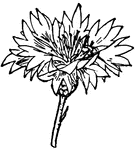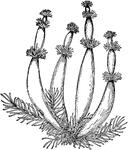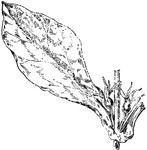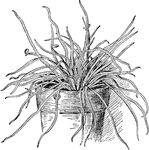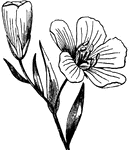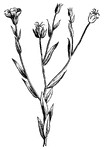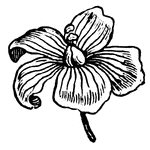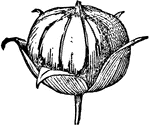241 illustrations of flowers and shrubs including: featherbells, featherfoil, finger flower, fireweed, flax, fleabane, forget-me-not, foxglove, fuirena, and fumitory
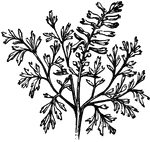
Common Fumitory
Fumitory, or Fumaria, is a genus of herbaceous plants belonging to the order Fumariaceae. The common…
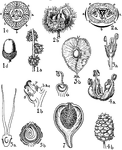
Fagaceae, Ulmaceae, and Moraceae Orders
Shown are the orders of Fagaceae, Ulmaceae, and Moraceae. Illustrated are various flowers and flower…
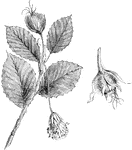
Branchlet of Fagus Sylvatica with Male and Female Flowers
The common name of fagus sylvatica is common beech. The male flowers have drooping heads. The female…
False Mermaid
Of the false mermaid family (Limnanthaceae), the false mermaid (Floerkea prosperpinacoides).

False Rue Anemone
The plant and fruit of the False Rue Anemone (Isopyrum biternatum). It is a flowering plant in the Ranunculaceae…

Fat-Hen
"7. a flower of Chenopodium album; 8. a section of the same, showing the superior ovary; 9. its seed…
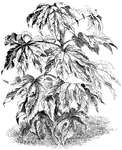
Fatsia Japonica
The leaves of the fatsia japonica shrub are a deep, shining green. The leaves are large and leathery.…
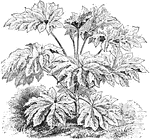
Fatsia Paprifera
The flowers on the fatsia paprifera shrub are greenish and grow on drooping stems. This shrub grows…
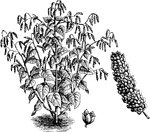
Prince's Feather
Also known as Polygonum orientale. A flower that is commonly found in southeastern Asia and Australia.…

Feathered Hyacinth
Feathered hyacinth is the common name of muscari comosum monstrosum. It is also called fair haired or…
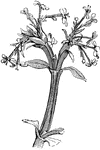
Flowering Branch of Fedia Cornucoplae
Fedia cornucoplae has red flowers that grow in clusters. The stem is a purplish color. The plant grows…

Fennel
Fennel (Foeniculum vulgare) is a plant species in the genus Foeniculum (treated as the sole species…
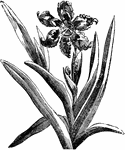
Flowering Spike of Ferraria Undulata
The flowers of ferraria undulata are greenish brown. The leaves overlap and taper to a slim point.
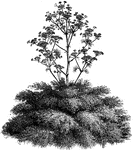
Ferula Communis
The common name of ferula is giant fennel. Ferula communis flowers are yellow. The height of the plant…

Ferula Tingitana
The common name of ferula is giant fennel. Ferula tingitana has yellow flowers. The plant grows between…

Feverfew
Feverfew (Tanacetum parthenium; syn. Chrysanthemum parthenium) is a traditional medicinal herb which…
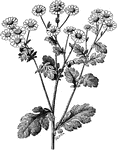
Feverfew
Feverfew is the common name of chrysanthemum parthenium. It is a strong scented perennial and grows…

Fiber
"Branching fiber, from spiral vessels of Gourd (Cucurbita Pepo)." — Encyclopedia Britanica, 1893

Ranunculus Ficaria
A plant with bright yellow flowers and short stems. They tend to bloom between March and May in Europe.
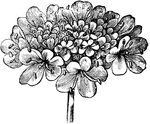
Inflorescence of Field Scabious
An illustration of the inflorescence of the field scabious. Knautia arvensis, commonly known as Field…

Ray-floret of Field Scabious
An illustration of a ray-floret of the field scabious. Knautia arvensis, commonly known as Field Scabious,…

Ray-floret of Field Scabious
An illustration of a ray-floret of the field scabious. Knautia arvensis, commonly known as Field Scabious,…

Seed of Field Scabious
An illustration of the seed of the field scabious. Knautia arvensis, commonly known as Field Scabious,…

Young Inflorescence of Field Scabious
An illustration of the young inflorescence of the field scabious. Knautia arvensis, commonly known as…

Adriatic Fig
A fig commonly seen in Adriatica; a body of water separating the Italian peninsula from the Balkan.

Figwort
This illustration shows a Figwort, a member of the genus Scrophularia. It has the characteristic features…

Maryland Figwort
"The inflorescence of Maryland Figwort (Scrophularia Marylandica). a, the flower; b, the fruit; c, a…

Fruiting Branchlet of Filbert
Filbert is a shrub that produces nuts, similar to the hazelnut. Filberts can be distinguished by the…

Leafless Twig of Filbert
In the early spring the pollen-bearing catkins appear before the female flowers. A shows the male catkins,…

Winter Catkins of Filbert
Filbert, hazel, and cobnut are all the common names of corylus. Illustrated are winter catkins of the…

Polypodium Filipes
A younger version of Polypodium tenellum. It is woody and wide-creeping when young.

Finger Flower
"Cheiranthera linearis; 2. its pistil and stamens; 3. a cross section of its ovary; 4. a seed of Pittosporum…
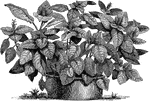
Fittonia Gigantea
The habit of fittonia gigantea is branching and erect. The flowers are pale red. The leaves are broad…
Five-ranked
Diagram of a shoot with its leaves 5-ranked, with a spiral line drawn from the attachment of one leaf…

Five-ranked
A ground-plan of the 5-ranked shoot; the section of the leaves; a dotted line drawn from the edge of…

flax
The flax plant supplied the threads required for the linen manufactured into clothing before cotton…
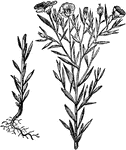
Flax
Flax (also known as common flax or linseed) (binomial name: Linum usitatissimum) is a member of the…

Flax Plant
"The most common variety of the flax plant has a very slender erect stem, two or three feet high, branching…

Flax Pod Cut in Half
Section lengthwise of flax seed cut half away, bringing contained embryo into view.
